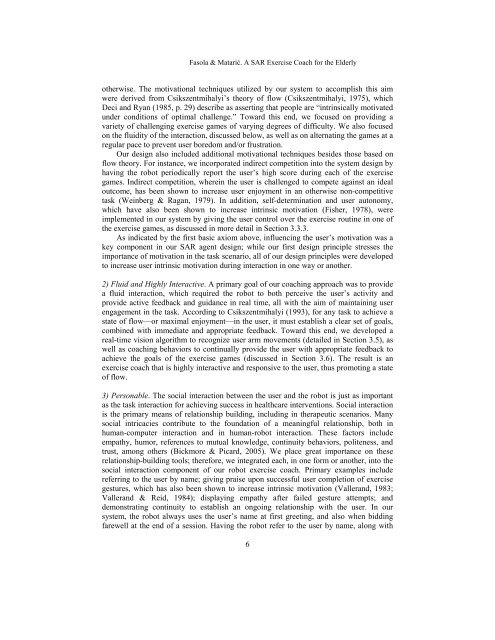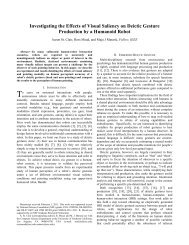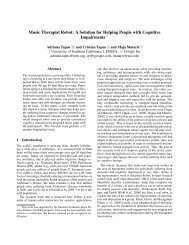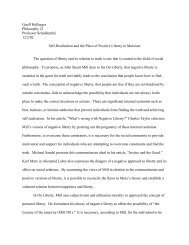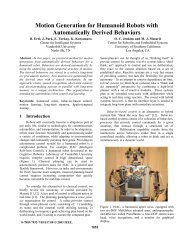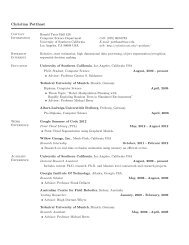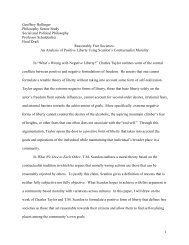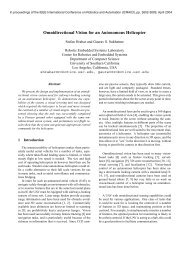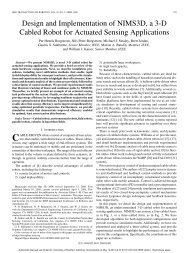A Socially Assistive Robot Exercise Coach for the Elderly
A Socially Assistive Robot Exercise Coach for the Elderly
A Socially Assistive Robot Exercise Coach for the Elderly
Create successful ePaper yourself
Turn your PDF publications into a flip-book with our unique Google optimized e-Paper software.
Fasola & Matarić. A SAR <strong>Exercise</strong> <strong>Coach</strong> <strong>for</strong> <strong>the</strong> <strong>Elderly</strong>o<strong>the</strong>rwise. The motivational techniques utilized by our system to accomplish this aimwere derived from Csikszentmihalyi’s <strong>the</strong>ory of flow (Csikszentmihalyi, 1975), whichDeci and Ryan (1985, p. 29) describe as asserting that people are “intrinsically motivatedunder conditions of optimal challenge.” Toward this end, we focused on providing avariety of challenging exercise games of varying degrees of difficulty. We also focusedon <strong>the</strong> fluidity of <strong>the</strong> interaction, discussed below, as well as on alternating <strong>the</strong> games at aregular pace to prevent user boredom and/or frustration.Our design also included additional motivational techniques besides those based onflow <strong>the</strong>ory. For instance, we incorporated indirect competition into <strong>the</strong> system design byhaving <strong>the</strong> robot periodically report <strong>the</strong> user’s high score during each of <strong>the</strong> exercisegames. Indirect competition, wherein <strong>the</strong> user is challenged to compete against an idealoutcome, has been shown to increase user enjoyment in an o<strong>the</strong>rwise non-competitivetask (Weinberg & Ragan, 1979). In addition, self-determination and user autonomy,which have also been shown to increase intrinsic motivation (Fisher, 1978), wereimplemented in our system by giving <strong>the</strong> user control over <strong>the</strong> exercise routine in one of<strong>the</strong> exercise games, as discussed in more detail in Section 3.3.3.As indicated by <strong>the</strong> first basic axiom above, influencing <strong>the</strong> user’s motivation was akey component in our SAR agent design; while our first design principle stresses <strong>the</strong>importance of motivation in <strong>the</strong> task scenario, all of our design principles were developedto increase user intrinsic motivation during interaction in one way or ano<strong>the</strong>r.2) Fluid and Highly Interactive. A primary goal of our coaching approach was to providea fluid interaction, which required <strong>the</strong> robot to both perceive <strong>the</strong> user’s activity andprovide active feedback and guidance in real time, all with <strong>the</strong> aim of maintaining userengagement in <strong>the</strong> task. According to Csikszentmihalyi (1993), <strong>for</strong> any task to achieve astate of flow—or maximal enjoyment—in <strong>the</strong> user, it must establish a clear set of goals,combined with immediate and appropriate feedback. Toward this end, we developed areal-time vision algorithm to recognize user arm movements (detailed in Section 3.5), aswell as coaching behaviors to continually provide <strong>the</strong> user with appropriate feedback toachieve <strong>the</strong> goals of <strong>the</strong> exercise games (discussed in Section 3.6). The result is anexercise coach that is highly interactive and responsive to <strong>the</strong> user, thus promoting a stateof flow.3) Personable. The social interaction between <strong>the</strong> user and <strong>the</strong> robot is just as importantas <strong>the</strong> task interaction <strong>for</strong> achieving success in healthcare interventions. Social interactionis <strong>the</strong> primary means of relationship building, including in <strong>the</strong>rapeutic scenarios. Manysocial intricacies contribute to <strong>the</strong> foundation of a meaningful relationship, both inhuman-computer interaction and in human-robot interaction. These factors includeempathy, humor, references to mutual knowledge, continuity behaviors, politeness, andtrust, among o<strong>the</strong>rs (Bickmore & Picard, 2005). We place great importance on <strong>the</strong>serelationship-building tools; <strong>the</strong>re<strong>for</strong>e, we integrated each, in one <strong>for</strong>m or ano<strong>the</strong>r, into <strong>the</strong>social interaction component of our robot exercise coach. Primary examples includereferring to <strong>the</strong> user by name; giving praise upon successful user completion of exercisegestures, which has also been shown to increase intrinsic motivation (Vallerand, 1983;Vallerand & Reid, 1984); displaying empathy after failed gesture attempts; anddemonstrating continuity to establish an ongoing relationship with <strong>the</strong> user. In oursystem, <strong>the</strong> robot always uses <strong>the</strong> user’s name at first greeting, and also when biddingfarewell at <strong>the</strong> end of a session. Having <strong>the</strong> robot refer to <strong>the</strong> user by name, along with6


